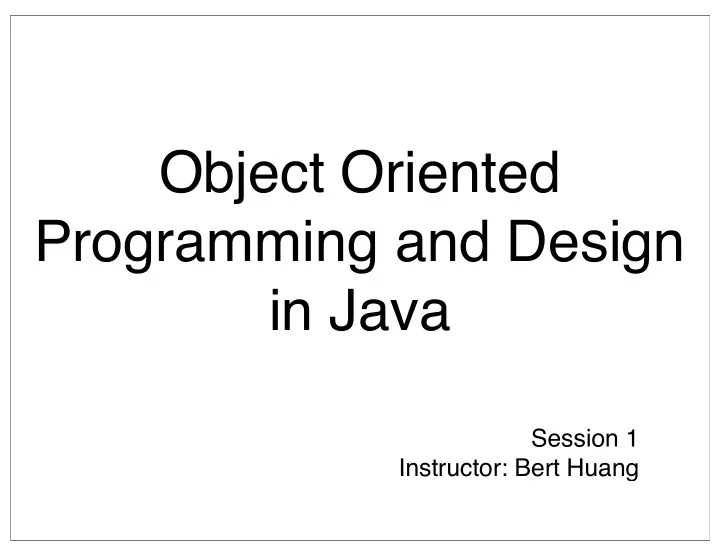

Object Oriented Programming and Design in Java Session 1 Instructor: Bert Huang
Today's Plan • Course information • Prerequisites • Assignments and expectations • Course goals
Room Situation • Tentatively here, 173 Macy, TC • Register ASAP so CS dept. can request registrar to assign bigger room
Course Information
Staff • Instructor: Bert Huang bert@cs.columbia.edu • 3rd year PhD Candidate (5th year graduate student) • TAs: John Graham Lauren Pulley more TBA
Schedule Sun Mon Tue Wed Thu Fri Class Class 11-12:15 11-12:15 John 1-3 Bert 2-4 CEPSR Lauren 624 5:30-7:30
COMS W1007 • The second course for majors in computer science. A rigorous treatment of object-oriented concepts using Java as an example language. Development of sound programming and design skills, problem solving and modeling of real world problems from science, engineering, and economics using the object-oriented paradigm.
Topics • Programming style • Encapsulation • Classes and • Inheritance methods • Design patterns • UML diagrams • Frameworks • Programming by • Java graphics and contract GUIs • Designing interfaces • Multithreading • Polymorphism
Prerequisites • COMS W1004: Intro to CS and Programming in Java • or AP CS with a grade of 4 or 5
Required Textbook • Object Oriented Programming and Design. Cay Horstmann • ISBN: 0-471-74487-5
Online Resources • Course website: http://www.cs.columbia.edu/~bert/courses/1007 • Book's website: http://www.horstmann.com/design_and_patterns.html • Courseworks: http://courseworks.columbia.edu
Grading • Five homework assignments, 10% each • Late policy: 10% penalty each day (up to three days) • Midterm exam, 20% • Final exam, 30%
Programming Assignments • Programs must compile and run in Java SE 6 (build 1.6.0_17-b04) • version currently on CUNIX machines • We will use graphics, so you'll need an X11-capable machine to run off CUNIX • You may want to use IDE like Eclipse
Academic Honesty • http://www.cs.columbia.edu/education/honesty • 1st offense: grade of zero, report to dean • 2nd offense or major violation: fail course, report to dean • Catching academic dishonesty in CS is easy • All work in this class is individual; no collaboration
Expectations • Start early • Ask questions in class (raise your hand) • or office hours, message board, email • Clarity • Seek extra help
Course survey • 1 point extra credit on final grade • Help me calibrate the course • http://spreadsheets.google.com/ viewform? hl=en&formkey=dGtMam5GMEctQVlsQ mpMaFdJUXo2MVE6MA • (or link off the course homepage)
Java Skills You Should Have • Compiling a Java program • Input/output via console or file system • Basic graphical interface • commenting for javadoc • (Programming in an IDE)
Course Goals
Why Study OOP and Design? • Writing a code is easy • Understanding code is hard • Good organization and design of programs makes understanding easier
Bad Design: Goto 1. if (stillRunning()) 2. doSomething() 3. goto 1 while(stillRunning()) doSomething()
What is OOP? • A style of programming where all components of computer programs are considered objects • objects have state, behavior, identity • Guidelines and practices to maintain this abstraction intelligently
Designing a Car Racing Game • Daunting at first, but identify the objects • Car objects and a Track object interact with a Physics object • then decide responsibilities of classes • Car stores velocity, size, location. Controls • Track stores boundaries, start, finish • Physics determines collisions, adjusts momentum
The Wisdom of OOP • Breaking down the program into pieces provides bite-sized goals • By generalizing programs to object interactions, common patterns appear • Want different types of tracks? Inheritance and polymorphism
Reading • Course website/syllabus • Survey • Academic honesty policy • Horstmann Ch. 1 - Java review
Recommend
More recommend